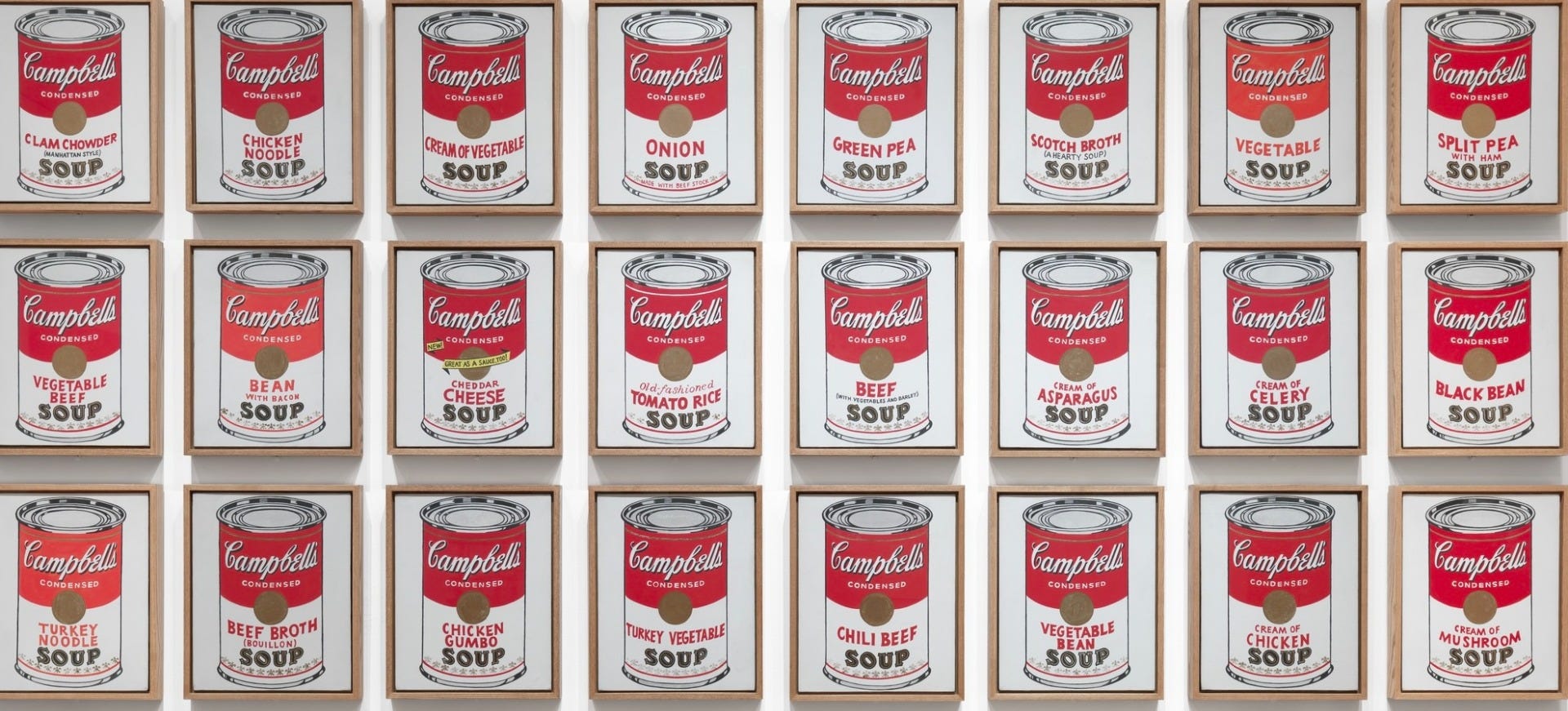Why Andy Warhol's Soup Cans are a Timeless Choice for Interior Design
- Dec 10, 2024

Image: Andy Wharol's Campbell’s Soup Cans
Why Andy Warhol’s Soup Cans are a Timeless Choice for Interior Design
Andy Warhol’s Campbell’s Soup Cans have captivated audiences since their debut in 1962, remaining as relevant and visually striking today as they were over half a century ago. This iconic series has transcended the boundaries of art and design, becoming a symbol of both Pop Art and contemporary culture. But what makes these seemingly simple soup cans such a timeless choice for interior design? Why are they still a staple in conversations about art and aesthetics in spaces like homes, offices, and even art fairs like Art Basel 2024?
Let’s delve into why Warhol’s Campbell’s Soup Cans remain a brilliant design choice and explore how their cultural significance continues to elevate them as more than just decoration.
Warhol’s Genius: Merging Commercial Design and High Art
Andy Warhol’s background as a commercial illustrator played a significant role in the creation of Campbell’s Soup Cans. Before his rise to fame as a Pop Art icon, Warhol was known for his innovative advertisements, particularly his stylish shoe illustrations. His deep understanding of consumerism and mass appeal allowed him to transform a mundane object—a can of soup—into an enduring work of art.
The brilliance of the Soup Cans lies in their ability to straddle the line between two worlds: the ordinary and the extraordinary. Warhol took something as ubiquitous as Campbell’s soup and elevated it, forcing viewers to reconsider the objects of everyday life. By turning a commercial product into art, he blurred the lines between high art and mass culture, creating a piece that feels both accessible and avant-garde.
A Bold Reimagination of Traditional Art
In the early 1960s, when Warhol introduced the Soup Cans, art was dominated by themes of beauty, landscapes, and emotional depth. Warhol shattered these conventions. His subject was not a lush garden or an emotional abstraction—it was a row of mass-produced soup cans. This radical departure from tradition was both a critique and a celebration of consumer culture.
Warhol’s work challenged the idea that art must represent beauty or emotion. Instead, he made the case that art could emerge from the ordinary. In choosing a subject as mundane as a soup can, Warhol sparked a dialogue about what art is and what it can be. This daring reimagination of traditional art themes makes Campbell’s Soup Cans not just visually appealing, but intellectually stimulating—a perfect conversation starter for any interior design.
The Visual Appeal of the Soup Cans
Great interior design often hinges on elements that are timeless, visually striking, and thought-provoking—qualities Warhol’s Soup Cans embody. Their clean lines, vibrant colors, and repetitive patterns create a bold yet balanced aesthetic. Whether displayed as a single print or a grid of multiple cans, they inject personality and a sense of modernity into any space.
Warhol’s Soup Cans also offer versatility in design. Their minimalist presentation complements both modern and eclectic interiors. For those looking to create a statement wall or add a touch of Pop Art flair, the Soup Cans are an ideal choice. Their reputation as a cultural icon amplifies their impact, drawing admiration and sparking curiosity from anyone who sees them.
Cultural Resonance: A Lasting Legacy
The Campbell’s Soup Cans are more than just art—they’re a piece of history. As one of the most recognizable works of the Pop Art movement, they represent the cultural zeitgeist of the 1960s, a time when consumerism and mass production were reshaping society. Warhol’s decision to highlight these themes in his art makes the Soup Cans perpetually relevant.
This cultural resonance is why Warhol’s work continues to thrive at events like Art Basel 2024, where collectors and enthusiasts seek art that is both historically significant and visually captivating. At Art Basel, contemporary art often finds new meaning in modern contexts, and Warhol’s work stands out as a reminder of the power of simplicity in a world of excess.
Why Choose Soup Cans for Your Space?
Decorating with Warhol’s Campbell’s Soup Cans goes beyond aesthetics—it’s a statement. It’s a nod to the evolution of art, a celebration of consumer culture, and an embrace of bold design. Unlike traditional works by Picasso or Van Gogh, Warhol’s Soup Cans invite viewers to reflect on their relationship with everyday objects and the cultural forces that shape their lives.
Their universal appeal makes them perfect for any setting, from a chic living room to a dynamic office space. By choosing the Soup Cans, you’re not just adding art to your walls—you’re bringing in a piece of history, a conversation starter, and a timeless symbol of creativity.
Conclusion
Warhol’s Campbell’s Soup Cans are more than just a timeless piece of interior design—they’re a cultural icon that continues to shape how we view art and consumerism. Their bold simplicity, historical significance, and ability to blend into diverse spaces make them a perfect choice for anyone looking to elevate their décor.
Whether you’re attending Art Basel 2024 or simply seeking to bring the vibrancy of Pop Art into your home, Warhol’s Soup Cans offer a unique blend of beauty, intellect, and cultural relevance. After all, great art is not just about looking great—it’s about making you think, and the Soup Cans do just that.






